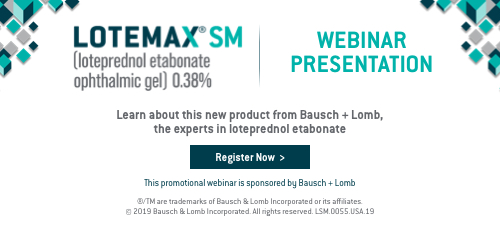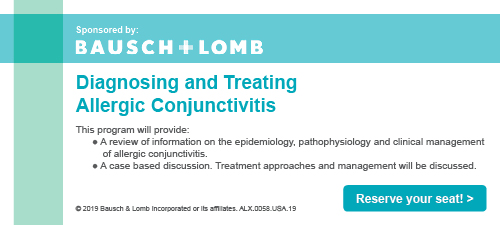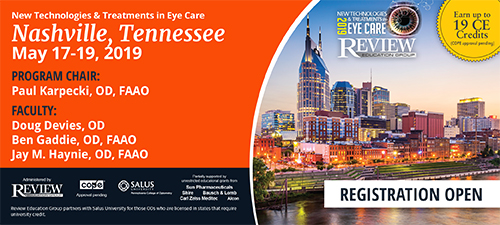
A
weekly e-journal by Art Epstein, OD, FAAO
Off the Cuff: The Importance of Stable Tears
A few years ago, I unexpectedly found a surprising number of dry eye patients with night time exposure. Beyond discovering poor lid closure or a band of inferior staining during the slit-lamp exam, just talking to the patient usually gave it away. The severely affected complained that their eyes were so dry when they slept that they had to keep a bottle of artificial tears on the nightstand in case they woke in the middle of the night. For patients who slept through the night, many shared that upon waking, their eyes felt like sandpaper and they could barely get them open in the morning. Virtually all reported dry eye symptoms that began early and only worsened as the day wore on. This epiphany and subsequent management strategy, using nighttime moisture tight goggles was game changing for many patients. They not only didn’t wake with discomfort, but also found their dry eye issues were dramatically reduced. For a long time, my reasoning made sense, but more recently, I started to suspect that the relationship between exposure and dry eye was more complicated than I initially thought. Does exposure cause tear instability and lead to the signs and symptoms of dry eye, or are the signs and symptoms of exposure a result of an unstable and poorly protective tear film? In other words, are properly functioning tears important even while the eyes are closed? A probable answer is suggested by looking at infants and young children who sleep with their eyes open. This happens so frequently that worried parents asking if this is normal is among the more frequently Googled eye questions in this age group. Yet, rarely do these children have issues. Apparently, a healthy stable tear film in young kids remains protective whether the eyes are open or closed. The likely conclusion? Tear stability is perhaps the most critical factor in maintaining homeostasis of the ocular surface.Editor’s Note: It is with great sadness that I report the passing of Dr. Beth Kneib. Many of us worked with Beth at one time or another in the many roles she served for our profession. Every optometrist practicing today was touched by her. Andy Morgenstern wrote a beautifully eloquent and moving obituary. You can read it here.
|
|||||
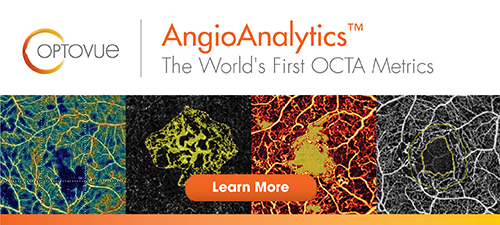 |
||
| Efficacy and Safety of Dexamethasone Intravitreal Implant in Patients with Retinal Vein Occlusion Resistant to Anti-vEGF Therapy: a 12-month Prospective Study | ||||
This prospective interventional case series of 13 BRVO and 10 CRVO patients with persistent macular edema (>250μm) after at least five anti-VEGF injections evaluated the safety and efficacy of repeated intravitreal dexamethasone implant (Ozurdex) injections administered on an as-needed protocol for retinal vein occlusion patients with macular edema with poor or no response to anti- VEGF injections. Exclusion criteria included: baseline visual acuity worse than 1.5 logMAR, previous intravitreal implant, history of vitreoretinal surgery, manifest glaucoma or ocular hypertension, epiretinal membrane, retinal neovascularization, massive retinal or macular ischemia, vitreous hemorrhage or severe lens opacity, previous laser photocoagulation treatment.
Each patient received an initial intraocular dexamethasone implant, and the procedure was repeated at six months as needed. Patients were followed up at months two, four, six, eight, 10 and 12 with spectral-domain OCT and best-corrected visual acuity measurements. Exclusion criteria included: baseline visual acuity worse than 1.5 logMAR, previous intravitreal implant, history of vitreoretinal surgery, manifest glaucoma or ocular hypertension, epiretinal membrane, retinal neovascularization, retinal or macular ischemia, vitreous hemorrhage or severe lens opacity, previous laser photocoagulation treatment. Patients on topical or systemic corticosteroid therapy (during the last three months), and known steroid responders as well as diabetic patients were also excluded. In the BRVO group, the mean CRT and BCVA significantly improved from 482.92 ±139.99μm (0.55 ±0.12 logMAR) at baseline, to 369.31 ±119.72 μm (0.43 ±0.18 logMAR) at six months. At 12 months CRT was 295.82 ± 135.48 μm and BCVA 0.29 ± 0.17 logMAR. Minimum CRT values were achieved at 3.45 months after the first injection, and 2.46 months after the second injection (197.00 ± 84.27 and 180.00 ± 76.89 μm respectively). Best BCVA values were achieved at a mean of 4 ± 0.853 months after the first injection, and four months after the second injection (0.219 ± 0.129 and 0.222 ± 0.078 logMAR respectively). In the CRVO group, neither the mean CRT nor BCVA improved significantly at six months: from 669.70 ± 203.20 μm (0.80 ± 0.231 logMAR) at baseline, to 586.20 ± 237.63 μm (0.740 ± 0.268 logMAR) at six months. At 12 months CRT was significantly improved: 549.90 ± 191.26 μm, but BCVA lacked significant improvement: 0.690 ± 0.285 logMAR. Minimum CRT values were achieved at a mean of two months after the first injection, and also two months after the second injection (261.60 ± 121.31 and 280.00 ± 177.43 μm respectively). Best BCVA values were achieved at a mean of two months after the first injection, and two months after the second injection and were 0.390 ± 0.173 and 0.385 ± 0.233 logMAR respectively. Cataract progression was a rare event (2/23 eyes), while transient steroid-induced ocular hypertension (5/23 eyes) was managed successfully with IOP-lowering medication. Researchers wrote that dexamethasone implants should be considered as an effective and safe alternative in patients with BRVO and CRVO who have failed anti-VEGF therapy. They added that shortening the re-injection interval especially for CRVO cases should be considered. |
||||
SOURCE: Georgalas L, Tservakis I, Kiskira E, et al. Efficacy and safety of dexamethasone intravitreal implant in patients with retinal vein occlusion resistant to anti-VEGF therapy: A 12-month prospective study. Cutan Ocul Toxicol. 2019:1-32. |
||||
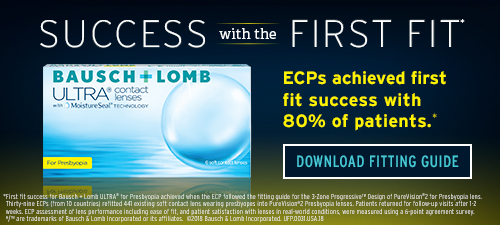 |
||
| Acute Angle-Closure Glaucoma Secondary to a Phakic Intraocular Lens, an Ophthalmic Emergency | ||||
Implantable collamer lenses (ICL) are phakic (natural lens remains in place) lenses that were first developed in the 1990s for correction of high myopia. The effectiveness and safety of ICLs are making them an increasingly popular option for vision correction in the myopic patient, competing with traditional options like glasses, contacts and procedures such as laser-assisted in situ keratomileusis. Although generally safe, due to the position of the phakic ICL in the eye, pupillary block remains a rare but vision-threatening complication of ICL implantation. Pupillary block caused by phakic ICL is a serious complication that requires urgent recognition and intervention and is poorly described in emergency medicine literature. Authors described a case of pupillary block five years after ICL implantation that was refractory to standard medical therapy, highlighting the importance of early diagnosis and referral for more definitive therapy.
|
||||
SOURCE: Frost A, Ritter DJ, Trotter A, et al. Acute angle-closure glaucoma secondary to a phakic intraocular lens, an ophthalmic emergency. Clin Pract Cases Emerg Med. 2019;3(2):137-9. |
||||
 |
||
| Inner Retinal Layer and Outer Retinal Layer Findings After Macular Hole Surgery Assessed by means of Optical Coherence Tomography | ||||
A PubMed engine search was carried out using the terms "macular hole," "optical coherence tomography" and "optical coherence tomography angiography” to summarize the spectrum of optical coherence tomography (OCT) and OCT angiography (OCTA) features after full-thickness macular hole (MH) repair surgery. All reports published in English up to October 2018, irrespective of their publication status, were included. Tomographic signs analyzed were divided according to the involved portion of the retina in "inner retinal layers" and "external retinal layers." Despite predominantly involving the inner retinal layers, cystoid macular edema (CME) has been treated as a separate entity. A report on vessel density (VD) changes and the foveal avascular zone (FAZ) area modifications were included. Different clinical findings could be observed on OCT of patients who underwent MH repair surgery. There was general consent that retinal thinning involving primarily the retinal nerve fiber layer and the ganglion cell layer took place after surgery. In the postoperative period, the outermost retinal layers got progressively restored. Persistent defects in the ellipsoid zone or in the external limiting membrane correlated with worse postoperative visual outcome. Researchers wrote that OCTA has globally demonstrated that eyes after MH closure show a reduction in macular and paramacular VD and smaller FAZ areas, compared with control or fellow eyes. They wrote that clinicians should be aware of the most common tomographic findings to properly manage each condition. In addition, they added that significant advantages for the postoperative application of OCT and OCTA included non-invasiveness, rapid and simple execution, repeatability and precise measurements. |
||||
SOURCE: Cicinelli MV, Marchese A, Bandello F, et al. Inner retinal layer and outer retinal layer findings after macular hole surgery assessed by means of optical coherence tomography. J Ophthalmol. 2019;2019:3821479. |
||||
| News & Notes | ||||||||
| Academy 2019 and 3rd World Congress Registration & Housing Open The American Academy of Optometry and World Council of Optometry’s joint meeting, Academy 2019 Orlando and the 3rd World Congress of Optometry, will take place October 23 to 27 at the Orange County Convention Center in Orlando, Fla. Registration and housing are now open and early bird registration ends Aug. 23. The meeting will feature more than 450 hours of CE, and an extra day of CE has been added on Sunday, October 27. This year’s Plenary Session, titled “Today’s Research, Tomorrow’s Practice: WHO World Report on Vision: Opportunities for Optometry to Make an Impact,” will discuss the World Report on Vision on the distribution of eye disease and blindness across the globe and the disease burden these eye conditions pose on nations and regions. The keynote speaker from WHO will give attendees an overview of the organization’s efforts to tackle the extensive disease and blindness burdens on society throughout the world and where optometry fits into this effort. Speakers include Kovin Naidoo, OD, PhD, FAAO; Sandra Block, OD, MPH, FAAO; and a speaker from the World Health Organization. The Monroe J. Hirsch Research Symposium is titled “Gene Therapy for Ocular and Neurologic Disorders,” and contemporary issues in gene therapy will be discussed including Leber’s Congenital Amaurosis, animal models of glaucoma and Leber’s Hereditary Optic Neuropathy. Speakers will include Stephen Russell, MD; Abbott Clark, PhD; and Byron Lam, MD. The fifth joint symposium of the Academy and the American Academy of Ophthalmology titled “Addressing the Global Myopia Burden” will discuss the prevalence of myopia in the developed world. Read more. |
||||||||
| Takeda to Sell Xiidra to Novartis, Collaborates with Skyhawk Takeda Pharmaceutical Company entered into agreements to divest its Xiidra (lifitegrast ophthalmic solution) 5% product to Novartis and its TachoSil Fibrin Sealant Patch to Ethicon to focus on business areas core to its long-term growth and facilitate rapid deleveraging following its acquisition of Shire. Takeda will receive $3.4 billion upfront in cash and up to an additional $1.9 billion in potential milestone payments from Novartis, and approximately $400 million upfront in cash from Ethicon. Takeda intends to use the proceeds to reduce its debt. Read more. In addition, Skyhawk Therapeutics announced a strategic collaboration with Takeda in which Skyhawk will use its SkySTAR technology platform to discover and pre-clinically develop small-molecule treatments directed to certain neurological disease targets. Read more.
|
||||||||
| Aerie Announces Additional $100M Credit Facility with Deerfield Management Aerie Pharmaceuticals entered into an amendment of its existing credit agreement with certain affiliates of Deerfield Management Company. The amendment provides for an additional $100 million senior secured delayed draw term loan facility (the additional credit facility), pursuant to which Aerie may borrow up to $100 million in aggregate in one or more borrowings at any time on or prior to July 23, 2020. Aerie reported that it believes it has adequate cash and cash equivalents to support ongoing business operations including the commercialization of Rocklatan, and currently has no intention to draw on the additional credit facility. Read more. |
||||||||
|
||||||||
|
||||||||
|
Optometric Physician™ (OP) newsletter is owned and published by Dr. Arthur Epstein. It is distributed by the Review Group, a Division of Jobson Medical Information LLC (JMI), 11 Campus Boulevard, Newtown Square, PA 19073. HOW TO ADVERTISE |


